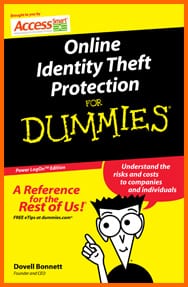Source: Online Identity Theft Protection for Dummies by Dovell Bonnett
 Physical identity theft occurs when thieves come in close contact with their victims or the information they’re stealing. For example, thieves may engage in dumpster diving where they look through garbage, or literally dumpsters to find papers with account numbers, addresses, name of family members, Social Security Numbers, drivers license numbers, or anything else that identified an individual.
Physical identity theft occurs when thieves come in close contact with their victims or the information they’re stealing. For example, thieves may engage in dumpster diving where they look through garbage, or literally dumpsters to find papers with account numbers, addresses, name of family members, Social Security Numbers, drivers license numbers, or anything else that identified an individual.
Are you sure you shredded last year’s bank statements? How about all that junk mail you tossed – no credit card offers in there, where there? If you are responsible for a corporate or small company, how likely is your administrative staff to shred or archive – NOT toss – sensitive documents?
Thieves will steal outgoing or incoming mail from your mailbox. They may also call you on the phone and pose as a company representative who needs to update their company’s files. If this happens, insist on returning their call and see how quickly they hang up on you!
You don’t even have to be the thief’s direct target when it comes to them trying to get to your information. They may go to a neighbor, friend, spouse, child, employer, or even pose as another company to get the information they seek.
The following is a list of other ways to for someone to physically steal your identity:
- Card skimming. Using a storage device to record your credit card or ATM magnetic stripe. When you hand your credit card to someone (think waiters) who then takes it away to process, it has now left your control and you have no idea what is actually being done with it while it is out of your possession.
- Computer theft. Stealing laptop or desktop computers with unprotected files has been active in the news, especially for companies and medical professionals. Individuals also store unprotected bank records, old electronic tax returns, stock portfolios, and other account information on their computers’ hard drives.
- Desktop snooping. The thief literally sits at your desk and rummages around looking for notes, sticky notes, pieces of paper, books, or anywhere you may have jotted down your passwords. So what is under your desk pad? Or on that sticky note in your top drawer?
- Dumpster diving. A person goes through another person’s or company’s trash looking for documents, cancelled checks, bank statements, employee records, addresses, pre-approved credit card applications and so much more.
- Fake ATM’s. What looks like an actual ATM machine is in reality a computer that record your PIN, copy all your magnetic stripe material, and then give the card back stating that the network is busy or out of service. The user then takes his/her card back and thanks nothing of it as he travels down the road looking for a working ATM.
- Filing a “Change of Address: form. The thief contacts a bank, post office, or utility company to put in a change of address request. This diverts your mail or statements to a new address that allows the thief access to your personal informaition until you actually realize that you are not getting your statements.
- Home/office burglary. Thieves break into a house or office to steal important papers, files and computers along with the easy to sell electronics, cash and jewelry. By making it look like a normal burglary, the identity thieves are obscuring the true purpose of the break-in, which is to obtain your personal identifying information.
- Postal mail theft. Stealing outgoing or incoming mail from a street-side mailbox. That red flat sticking up signaling that mail is in the box is not just letting your postal carrier know that there is mail in there. You are also letting thieve know that you are probably paying bills and they now have access to account numbers and your checking info if you are paying by check.
- Over-the-shoulder-surfing. Someone you know looks over your should while you type a password. This can be coworkers, friends and family members.
- Phone pretexting. Someone will call pretending to be from a legitimate company claiming that they need to update their records. Most people, recognizing that they do indeed do business with this company will give out their personal information without hesitation. Again, insist on calling them back.
- Purse and wallet theft. Pick pockets and purse snatchers are as active as ever due to all the important personal information that we keep in our wallets and purses. It is a very BAD idea to keep your Social Security card in your wallet!
- Social engineering attacks. Posing as a landlord, employer, or someone else who has legal, authorized access to your personal information. People all to often give out personal information to someone who looks authoritative and legitimate.
People are becoming increasingly aware of how physical identify theft occurs and are taking precautions such as shredding bills and other documents, renting post office box rather than leaving their mail at the curb and refusing to engage with telemarketers. As a result, identity thieves are looking for, and finding, other ways to obtain your personal information. The targets now are your computer, zip drives and of course, the internet.
For more information about how to safeguard your critical information, please order your FREE copy of Online Identity Theft Protection for Dummies.



